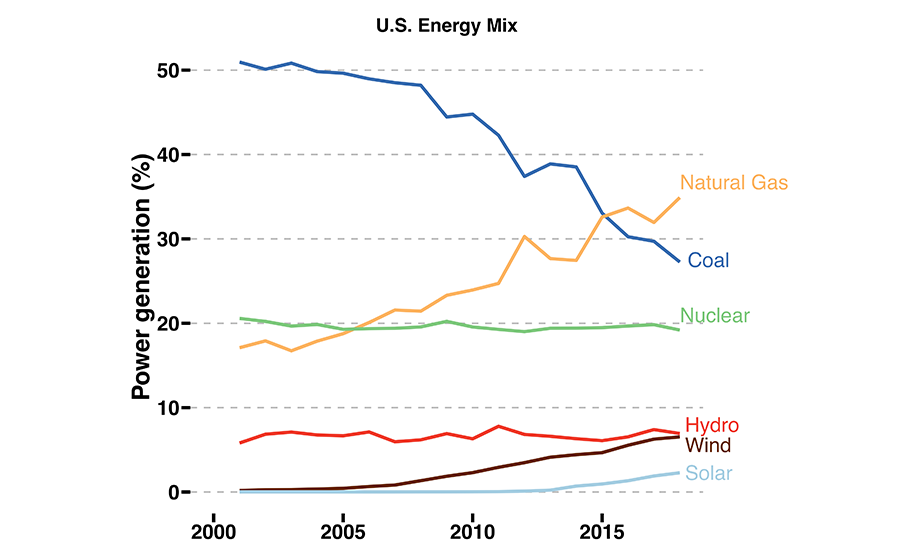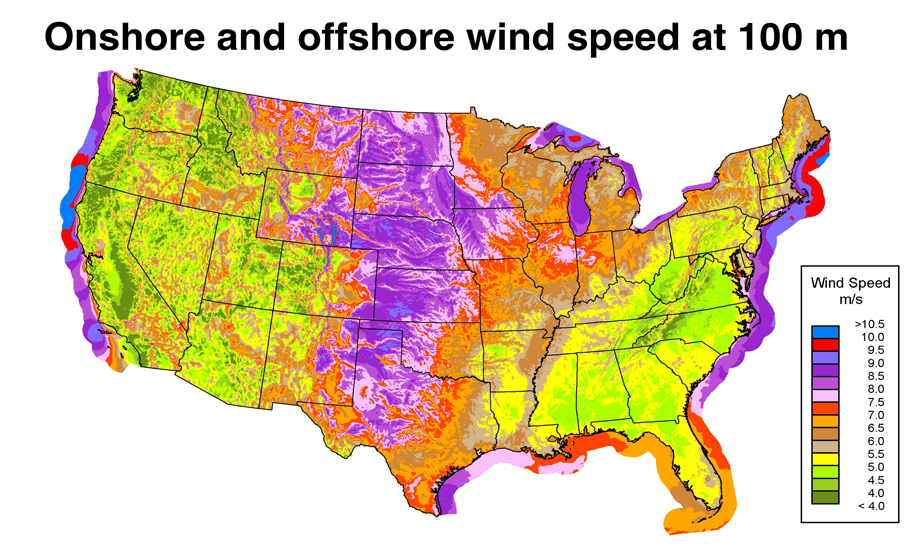DC can squeeze more power into existing transmission lines
Changing transmission lines from alternating to direct current has been long overlooked, but it may be the cheapest way to boost capacity on our over-taxed grid.
The U.S. energy system has seen sweeping changes in the past two decades. Natural gas replaced coal as the dominant fossil source of power generation, and wind and solar energy now contribute roughly 9% of the nation’s electricity, compared to almost none 20 years ago. Because of these changes, less carbon is being emitted by the power sector per unit of electricity produced. A transition towards a low-carbon power sector has begun.
Meaningful decarbonization of the energy system, however, will require not only new sources of energy but also new and expanded pathways to bring that clean power to consumers, especially as demand for electricity grows in the coming decades. How to expand the capacity of the U.S. electrical grid is the subject of a recent paper from researchers in the Engineering and Public Policy (EPP) department, published in the Proceedings of the National Academy of Sciences.

Source: Data: Power Sector Carbon Index, Scott Institute
Changes in U.S. power generation from 2001 - 2018.
“There is a widespread belief that the move to decarbonizing our energy system is going to give rise to more electrification,” said Granger Morgan, professor of engineering and public policy and senior author of the study, “and we'll have to move that power, somehow.”
Wind and solar are now the cheapest ways to produce energy in many parts of the country, with costs expected to continue to fall. However, places where that energy is in high demand, such as big cities and heavy industrial sites, are often located elsewhere. To make the most of renewable energy resources, the already-taxed grid must be expanded to move electricity from point A to point B. Along with his Ph.D. student, Liza Reed, and EPP faculty members Parth Vaishnav and Daniel Armanios, Morgan and his team have analyzed the costs of different upgrades aimed to increase the transmission capacity of the grid.

Source: National Renewable Energy Laboratory
Wind resources in continental U.S.
One way to expand the capacity of a transmission corridor is to string more, or thicker, wires within that corridor, but it’s an expensive option. Power lines are heavy, and adding thicker wires to carry more power requires building additional support structures and more land on which to build them on.
Simply shoving more current through existing wires to increase the capacity of a corridor may also not be an appealing way to increase capacity. The increased current causes additional heating within wires, which can cause them to sag too low, creating a potential fire hazard as they droop nearer to the surface or the tops of trees.
Building new corridors from scratch would increase the overall carrying capacity of the grid, but doing so presents its own set of challenges. New corridors require new land, new structures, and new wires, all of which are costly. For linear projects spanning hundreds of miles, it’s also a task fraught with political difficulties: to many, transmission lines are unsightly and require siting structures on private property. High-profile transmission projects, like the Plains & Eastern line that was designed to move thousands of megawatts of wind-generated electricity from the Oklahoma panhandle to the southeastern grid, have stalled in recent years due to political opposition and conflicts with land-owners.
“We got into this initially because it has become almost impossible to build much of anything new in this country,” said Morgan.
Decarbonizing our energy system is going to give rise to more electrification, and we’ve got to move that power, somehow.
M. Granger Morgan, Professor, Engineering and Public Policy
Instead of stringing new or thicker wires along an entire corridor, or building a new corridor altogether, Morgan and his team examined how capacity could be expanded by changing the nature of the electricity being carried by the wires, switching from predominantly-used alternating current (AC) to direct current (DC). The main finding of their work is that, for many corridors, converting from high-voltage AC (HVAC) to HVDC can be the most cost-effective way to deliver added electricity.
“One of the most important things about our finding is to at least get HVAC to HVDC conversions on the table,” said Morgan, an option that is generally not considered in typical expansion planning by utility companies.
“The beauty of the HVDC option,” said Liza Reed, lead author of the study, “is you can often use the same wires, and for the most part the same structures,” while increasing the capacity of the corridor. “That’s where the cost-savings come in.” Switching current from AC to DC can allow a given line to be operated at a higher voltage (compared to AC) without having to increase the current, avoiding the issue of increased sag with additional heating.
HVDC has traditionally only been considered a viable option for extremely long corridors, but Reed said their work shows HVDC conversion to be the cheapest way to increase capacity for many distances, even as low as 300 km. “We are challenging the conventional wisdom about HVDC,” she said.
Making the switch from HVAC to HVDC is not without cost, however. Additional inverter equipment is required to switch electrical current from DC to AC before being delivered to consumers at the end of the lines, a significant additional capital cost. Morgan and Reed both expect this technology to get cheaper in the coming years though, which would make the argument for HVDC conversions even more compelling than these current estimates.
As renewable energy sources continue making headway in the national energy mix, expanding high-voltage transmission will be an important option to get clean energy to consumers, often across long distances. Morgan and Reed show that upgrading existing corridors by swapping from AC to DC can often be the most cost-effective way to do so.
